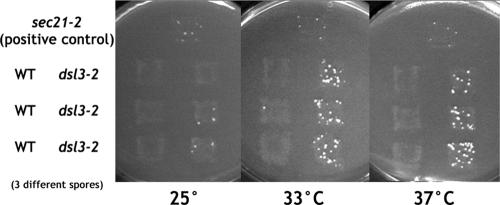The authors of “Dsl1p, Tip20p, and the Novel Dsl3(Sec39) Protein Are Required for the Stability of the Q/t-SNARE Complex at the Endoplasmic Reticulum in Yeast” (Mol. Biol. Cell [2005] 16, 3963–3977; published online before print as 10.1091/mbc.E05–01–0056) would like to make the following correction to their paper. The experiment shown in Figure 3B of this paper was erroneously performed with a strain of mating type a rather than α. Thus, the processing observed may have been due to the mating type-specific Bar1 protease. We repeated the experiment using a strain of mating type α at permissive and restrictive temperatures. As shown below (Figure 1), cleavage is observed in dsl3-2 mutants, although to a bit lower extent than in the experiment shown in Figure 3B of our manuscript. Thus, the mating type error did not have a substantive effect on the result and therefore the conclusion remains valid. Nonetheless, to obtain additional independent evidence for a defect in Golgi-ER retrograde transport in dsl3-2 mutants, we performed a mating assay described by Letourneur et al. (1994; Cell 79, 1199–1207). In this assay, mating of mutant cells with a tester strain of opposite mating type depends on the transport of a recombinant pheromone receptor that carries an ER retention signal. Figure 2 shows that diploid cells can form if the mutant cells were exposed to restrictive temperatures for 3 h in the presence of a tester strain. As a positive control, we included strain P82 (sec21-2; Letourneur et al., 1994; Cell 79, 1199–1207). This confirms that Dsl3(Sec39)p is involved in Golgi-ER retrograde transport. Thus, the interpretation of the original experiment was correct, despite the erroneous use of an a, rather than an α, strain.
Figure 1.




